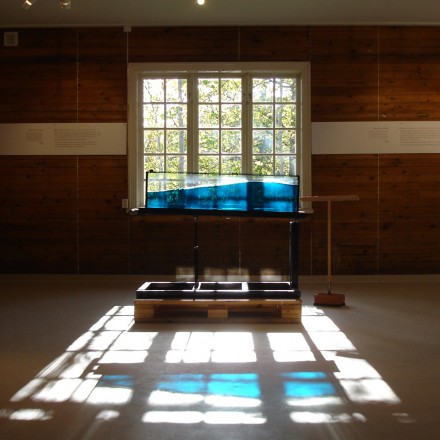Klas Fresk about the relation between design and message
”- As an educator and scientist, I was early convinced that design is relevant to how the message is understood. And that content and form are inextricably linked with each other. You can not create a content without a form and vice versa.”
It was at the Södertälje Konsthall 1985 that Tom Tits Experiment was shown for the first time. With inspiration from the activities called science-centers. At that time science centers existed in a few places in Northern America and Europe. In Sweden some were planned but not yet opened.
The creation was thus known as a science-center exhibition. The term science-center on this kind of activity was first used in what was built in 1964 in Seattle under the name of Pacific Science Centre. A relevant Swedish term has not yet been seen. The idea of science-centers can be traced back to the 1600s and Christopher Polhem and his mechanical alphabet.
A science center is primarily an educational project. The aim is to increase knowledge and interest in science and technology. This ambition has guided Tom Tits Experiment during the development, from the first exhibition in the artgallery to the major expansion 20 years later.
The idea was to build an exhibition on science and technology items that visitors themselves had to deal with. These so-called hands-on objects are the essence of a science center.
The objects, exhibits, are inherently appealing the way they invite visitors to join. The exhibits are designed to display various scientific phenomena and technological principle. Topics are nature of light, human anatomy, how the steering on a car works and so on. The subject area is huge and conceiving a science-center is often a question about to choose, and usually to opt out.
The question is what is suitable to show through a science-center exhibition? And what may fit better to present in a book, a movie or at a demonstration?
Within the science-center movement a number of exhibits and installations are developed to choose from. New inventions continuously adds. What are the exhibits that ultimately will be part of the planned exhibition is due to a number of factors. Not least important is the design aspect.
The main idea was that all people are interested in science and technology – if it is presented properly.
The question is then: What is the right way?
As an educator and scientist, I was early convinced that design is relevant to how the message is understood. And that content and form are inextricably linked with each other. You can not create a content without a form and vice versa. This means that an exhibition’s message can not be interpreted solely on the basis of the exhibited objects, images or text content, what is usually regarded as the actual exhibition.
How a message is perceived is also a question about how the objects are designed, materials, scale, color, placement, on plates design, size, placement, text fonts, the lighting, scenography and so on. Everything can be influenced in order to achieve a certain message.
An early intention was to bring a set designer to give the exhibition a spatial form. By a happy coincidence it happened to be a scenographer who was also a trained architect. Since then, during my 20 years as leader and manager, Tom Tits Experiment is developed by creative architects. Two architects have been influential; Håkan Wannerberg and Peter Sirkén.
The design has included everything: buildning and galleries, the exhibition objects, furnishings, lightings, staff working clothes, graphical form and website. All these decisions, selections and deselections creates the atmosphere of Tom Tits Experiment.
Return to the message. What was the message I wanted to convey? I wanted the visitor to feel invited and welcome to take part in what was ducat, exhibits and objects. That you as visitor felt competent, involved, think and feel your own way, get amazed, surprised, to choose your path, to choose what, when or how to approach an exhibit. Every property which can be summarized in one word: freedom.
Therefore, I intended to avoid the schoollike style of science-center which is quite common. The topic of science and technology in itself, smells school and institution. And this could be enhanced by the design if you’re not careful. The message must not have an undertone of school and pointers or perceived as pure science propaganda or an uncritical celebration of technology. It can easily bore and scare away any visitors whatsoever.
It is the way the subject is presented by design, shape and language which is crucial.
This is where the architect comes in and this already at the planning stage. An architects ability to portray the room, overlooking the big structure, create moods and solve practical problems is what determines how the message will be perceived.
An example is Maskineriet, one of the many galleries at Tom Tits Experiment designed by Peter Sirkén. Maskineriet was sponsored by Scania who contributed with money and objects. The intention was to present the nature of the machine. Not a propaganda of local successful industry but a report on what is a machine.
The dominant feature is a cut truck, in the form of cab, engine, gearbox and rear axle. How keep this away from a ”technology museum” in its negative sense? A manual is not available, but some manners are: silk curtains from floor to ceiling that matched the color of the cab. Common kitchen items that shows the technical principles of engine and transmission. A simple lever, mounted in a way that the even the smallest visitors can lift a 100-kilo weight. An industrialrobot was placed behind a barlike dish, with the task of challenging visitors in precision work.
The truck cab is among the most popular items among the younger children and attracts both boys and girls to play.
Another example is Tom Tits Garden, which Peter has designed in several steps. A garden full of exhibits, large and small, among others on the topic of wind, water and plants. Mixed up with a number of artinstallations as well. The gardensurface is about 10,000 square meters. It contains hundreds of exhibits located between the garden’s trees, shrubs and other plants.
Architects skill in find out spatialities, sight lines etc created a garden that is completely unique from designapproach point of view with a pleasent mixture of nature, scientific and technical installations.
So even though the Tom Tits Experiment, with its hands-on design, in a sense is like any other science-center at any time, it is quite different. The difference is obvious to any visitor who compares to other science-centers.
And the difference is due entirely to the very elaborate interplay between form and content.
………………………………………….
Article written 2011 by Klas Fresk for website www.sirken.se
Klas is the initiator and founder of the Tom Tits Experiment and CEO until 2007. Scientific, educational and artistic director of the new Tom Tits Experiment.
Scientist, teacher and teachertrainer from Södertälje who wanted to change the school, got an idea for a kind of science center, Tom Tits Experiment. Posseses a technology honorary doctorate at KTH and has written a number of books on pedagogy.

